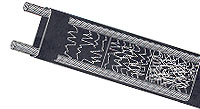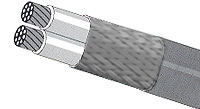guides
Introduction to Trace Heating
Heat Tracing – Steam or Electric?
The energy source for heat tracing is most commonly electricity or steam. When excess steam is available, it may, incorrectly, be perceived to be ‘free’. But steam tracing is rarely controlled and may typically deliver six times the quantity of heat required to provide freeze protection to a pipe. Additionally, it has high running and maintenance costs due to leaks from steam traps.
Heat Tracing – The Need
Whenever the contents of a pipe or equipment are maintained at a process temperature exceeding the ambient temperature, there will be a flow of heat from the product or equipment through the thermal insulation to the external air, and the rate of heat loss varies directly with changes in ambient temperature.
Heat Tracing – What is its purpose?
Heat Tracing is usually provided to maintain a product or equipment at a temperature that will prevent processing problems. For example:-
Heat Tracing – What is it?
Heat Tracing (or Trace Heating, or Surface Heating) is the method of applying heat to a body, or to a product (liquid, powder, or gas) contained within a system (pipework, vessel or equipment) for storage or transportation, in order to avoid processing problems or difficulties.
The Various Heating Cable Technologies
There a various heating technologies but the main 4 are covered below
An Overview of the technologies
Electric trace heating cable can be divided into four distinct product classifications. They vary from semi-rigid mineral insulated heating cables (MIHC) to the highly flexible, plastic sheathed and the conductive polymer heating cable.
The four commonly used types are:
- Self-regulating parallel circuit heating cable (variable watt output) - operating temperatures up to 300°C
- Zonal parallel circuit heating cable (constant watt output) - operating temperature up to 425°C
- Series circuit heating cable (constant watt output) - operating temperature up to 425°C
- Mineral insulated series circuit heating cable - operating temperature applications up to 600°C
 Self-regulating heating cables are designed to regulate their output. As the process temperature drops, the cable's output increases; conversely, as the temperature rises, the cable's output decreases. The main benefit is that, when inherently temperature-safe, self-regulating heaters are incapable of overheating or burning out
Self-regulating heating cables are designed to regulate their output. As the process temperature drops, the cable's output increases; conversely, as the temperature rises, the cable's output decreases. The main benefit is that, when inherently temperature-safe, self-regulating heaters are incapable of overheating or burning out  Burning Out:
Burning Out:
In constant wattage heaters, if the cable overlaps itself, there is a potential that there will be enough heat generated so as to exceed its own maximum operating temperature and therefore destroy or 'burn itself out' due to self-generated heat. Being of parallel resistance, they can be cut-to-length without affecting W/m output.
 Constant wattage heating cables combine features of series and parallel resistance heating cables. Their parallel bus wire construction and uniform output characteristics make them easy to apply in the field. Being of parallel resistance, they can be cut-to-length without affecting W/m output. A variation of this construction is a power limiting version, whose output reduces with increasing temperature to a certain extent
Constant wattage heating cables combine features of series and parallel resistance heating cables. Their parallel bus wire construction and uniform output characteristics make them easy to apply in the field. Being of parallel resistance, they can be cut-to-length without affecting W/m output. A variation of this construction is a power limiting version, whose output reduces with increasing temperature to a certain extent
 Series constant wattage cables comprise one or more resistance wire heating resistors connected to form a series or series-parallel electric circuit insulated and/or covered in a suitable insulating material, often polymeric or elastomeric. Being of series resistance, these heating circuits must be individually designed for length, power output, and supply voltage
Series constant wattage cables comprise one or more resistance wire heating resistors connected to form a series or series-parallel electric circuit insulated and/or covered in a suitable insulating material, often polymeric or elastomeric. Being of series resistance, these heating circuits must be individually designed for length, power output, and supply voltage
 Mineral insulated (MI) heating cables are the most rugged and durable type of heating cable. Due to their construction, they can have very high watt output which can be used in some process heating applications. Being of series resistance, MI heating circuits must be individually designed for length, power output, and supply voltage
Mineral insulated (MI) heating cables are the most rugged and durable type of heating cable. Due to their construction, they can have very high watt output which can be used in some process heating applications. Being of series resistance, MI heating circuits must be individually designed for length, power output, and supply voltage
Registered Users and Members have access to much more content. Register for free to activate the extra features of the website
Registered Users also have the advantage of extra information in the form of in-line Glossary This is Glossary Item
This is Glossary Item
We expand even more on standard terminology used in the industry. items. Simply hover your mouse over the item highlighted and more information will appear.
